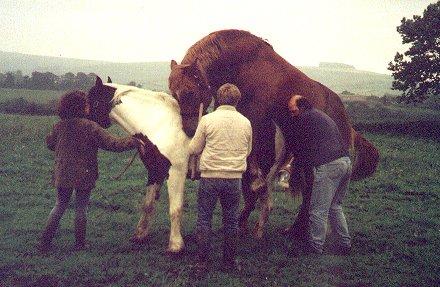|
|
ARTIFICIAL
INSEMINATION
The use of Artificial Insemination has long
been acknowledged as being acceptable in the cattle and sheep breeding
industries, but it is only recently that horse breeders have begun to
realise its potential.
This in itself is an interesting fact as
according to some writers the earliest recorded semen collection and insemination
took place in 1322 when an Arab chief used artificial methods for the
successful insemination of a prize mare. Purportedly he used semen stealthily
collected from the sheath of a stallion belonging to an enemy chieftain.
There is no evidence, however, to indicate that the ancient tribesmen
practised artificial insemination in any appreciable degree.
In the European horse breeding industry experiments
into the collection and use of semen for AI were carried out as far back
as 1890. Much of the initial research took place in France, Germany and
Denmark and it is interesting that these countries, together with Holland,
are today at the forefront of equine AI.
Originally AI was viewed as a way of overcoming
sterility but in 1902 at the Northern Livestock Conference in Copenhagen
it was brought to delegates attention that the use of AI had potential
for the widespread improvement of farm animals. It was in Russia in 1899
that the first extensive study into the use of AI in horses was undertaken.
At the request of the chief of the Royal Russian Stud a study was made
into the use of AI. Under the direction of E.I Ivanoff AI was practised
by numerous studs, but the results were not uniformly good. He noted,
however, that where he did the work or where it was done under his supervision,
the conception rate was somewhat higher than that obtained by natural
mating. As a result of his work with horses Ivanoff then began to work
with both cattle and sheep and was the first to undertake successfully
the artificial insemination of both species. It is interesting to note
that the use of AI is now much more widespread with cattle and sheep than
with horses!

The collection of semen
In order for semen to be imported to or exported
from the UK it is necessary for the stallion to be quarantined for a minimum
period of 30 days and to be tested for a number of diseases such as EVA,
Equine Infectious Anaemia and CEM. This is to safeguard the mares on whom
the semen is to be used and their unborn foals.
When thinking about using imported frozen
semen consideration should also be given to the quality of the semen which
is being provided. When importing semen from countries other than those
in the European Union licences from the Ministry of Agriculture must be
obtained as well as export licences and health certificates from the competent
authority in the exporting countries. If
the semen is being imported from a EU country it should be accompanied
by the relevant health certificates but does not now require import and
export licences.
For stallion owners in the UK the option
of having semen collected and frozen from their stallion for future use
opens up a whole new dimension to the services which they can offer. Collection
and storage of semen for use within the UK is primarily seen as an insurance
policy should the stallion be injured. It also enables a stallion who
is competing to fulfil his stud duties whilst still concentrating on a
competitive career. It is further possible to store semen so that bloodlines
can be re-introduced at a later date; this is particularly useful where
the progeny of a stallion prove themselves after his death.
By having semen collected for export the
stallion owner can sell coverings from his stallion all year round. When
the covering season in the northern hemisphere is coming to a close the
season in the southern hemisphere is just getting underway. Whilst quarantining
and transporting a stallion to Australia for the breeding season may not
be cost effective, not to mention very stressful for the stallion, the
collection and export of frozen semen could be!
The quarantining of stallions for the collection
of semen for export involves testing for various diseases as laid down
by the competent authority of the importing country. This has to be carried
out at a MAFF approved quarantine facility by a veterinary surgeon approved
by the Ministry of Agriculture in the UK. After the tests have been carried
the semen is collected, frozen and stored prior to shipping.
Exporting semen from the UK to countries
worldwide is a way of spreading the genetic base and introducing new bloodlines
into countries without the risk or expense of transporting the stallion.
A number of countries do not allow the importation of in-foal mares so
it is not possible to send a mare to a stallion in the UK and then return
her home before foaling.
The AI Centre has Ministry of Agriculture
approved Stallion Quarantine and Semen Collection Centres throughout the
UK offering stallion owners a complete semen collection, evaluation and
freezing service. Advice and assistance can be given to those wishing
to provide chilled semen from their stallions and also to those who wish
to have semen frozen. If a stallion owner prefers we can visit their premises
to collect and process semen for use within the UK. They are also happy
to help mare owners who wish to use AI.
This article is kindly
provided by the AI Centre.
For further information please visit
their website -click
here |
 |
|

